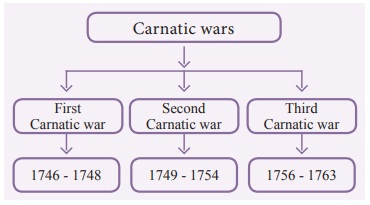From Trade to Territory | Chapter 2 | History | 8th Social Science - Carnatic wars | 8th Social Science : History : Chapter 2 : From Trade to Territory
Chapter: 8th Social Science : History : Chapter 2 : From Trade to Territory
Carnatic wars
Carnatic wars
In the 18th century, three Carnatic
wars were fought between various Indian rulers, British and French East Indian
Company on either side. Traditionally, Britain and France were rival countries
in Europe. Their rivalry continued in India over trade and territories. It
resulted in a series of military conflicts in the south known as the Carnatic
wars which spanned from 1746 to 1763. These wars resulted in establishment of
political supremacy of British East Indian Company.

First Carnatic war
(1746 - 48)
On the outbreak of the Austrian war
of succession in Europe the English and the French were on opposite camps
increased the hostility between these two forces. The echo of this war was felt
in India.
Battle of Adayar (1746)
The First Carnatic War is remembered
for the battle of Santhome (Madras) fought between the French forces and the
forces of Anwar-ud-din, the Nawab of Carnatic, who appealed the British for help.
A small French army under Captain Paradise defeated the strong Indian army
under Mahfuz Khan at Santhome on the banks of the River Adayar. This was the
first occasion when the superiority of the well-trained and well-equipped
European army over the Indian army was proved beyond doubt.
Treaty of Aix-la-Chapelle (1748)
The war was ended by the treaty of
Aix-la-Chapelle which brought the Austrian War of Succession to an end. Under
the terms of this treaty, Madras was returned back to the English, and the French,
in turn, got their territories in North America.
Second Carnatic War
(1749 - 54)
The main cause of this war was the
issue of succession in Carnatic and Hyderabad. Anwaruddin Khan and Chanda Sahib
were the two claimants to the throne of Carnatic, whereas Nasir Jang and
Muzaffar Jang were claimants to the throne of Hyderabad. The French supported
Chanda sahib and Muzaffar Jang, while the British supported the other claimants
with the objective of keeping their interest and influence in the entire Deccan
region.
Battle of Ambur (1749)
Finally Dupleix, Chanda Sahib and
Muzaffar Jang formed a grand alliance and defeated and killed Anwar-ud-din
Khan, the Nawab of Carnatic, on 3 August 1749 in the Battle of Ambur. Muhammad
Ali, the son of Anwar-ud-din, fled to Trichinopoly (Trichirappalli). Chanda
Sahib became the Nawab of Carnatic and rewarded the French with the grant of 80
villages around Pondicherry.
In the Deccan, too, the French
defeated and killed Nasir Jang and made Muzaffar Jang as the Nizam. The new
Nizam gave ample rewards to the French. He appointed Dupleix as the governor of
all the territories in south of the river Krishna. Muzaffar Jang was
assassinated by his own people in 1751. Salabat Jang, brother of Nasir Jang was
raised to the throne by Bussy. Salabat Jang granted the Northern Circars
excluding the Guntur District to the French. Dupleix’s power was at its zenith
by that time.
Battle of Arcot (1751)
In the meantime, Dupleix sent forces
to besiege the fort of Trichy where Muhammad Ali had taken shelter. Chanda
Sahib also joined with the French in their efforts to besiege Trichy. Robert
Clive’s proposal was accepted by the British governor, Saunders, and with only
200 English and 300 Indian soldiers, Clive was entrusted the task of capturing
Arcot. His attack proved successful.

Robert Clive defeated the French at
Arni and Kaveripak. With the assistance of Major General Stringer Lawrence, Chanda
Sahib was killed in Trichy. Muhammad Ali was made the Nawab of Arcot under British
protection. The French Government recalled Dupleix to Paris.
Treaty of Pondicherry (1755)
Dupleix was succeeded by Godeheu who
agreed the treaty of Pondicherry. According to it, both the powers agreed not
to interfere in the internal affairs of the native states. They were to retain
their old positions. New forts should not be built by either power. The treaty
made the British stronger.
The second Carnatic war also proved
inconclusive. The English proved their superiority on land by appointing
Mohammad Ali as the Nawab of Carnatic. The French were still very powerful in
Hyderabad. However, the predominant position of the French in the Deccan
peninsula was definitely undermined in this war.
Third Carnatic War
(1756 - 63)
The outbreak of the Seven Years’ War
in Europe led to the third Carnatic war in India. By this time, Robert Clive
established the British power in Bengal by the Battle of Plassey which provided
them with the necessary finance for the third Carnatic war.
Count de Lally was deputed from France
to conduct the war from the French side. He easily captured Fort St. David. He
ordered Bussy to come down to the Carnatic with his army, to make a united
effort to push the British out of the Carnatic. Taking advantage of Bussy’s
departure, Robert Clive sent Colonel Forde from Bengal to occupy the Northern
Circars (parts of Andhra Pradesh and Odhisha).
Battle of Wandiwash (1760)
The decisive battle of the third
Carnatic war was fought on January 22, 1760. The English army under General
Eyre Coote totally routed the French army under Lally. Within a year the French
had lost all their possessions in India. Lally returned to France where he was
imprisoned and executed.
Treaty of Paris (1763)
The Seven Years’ War was concluded
by the treaty of Paris. The French settlements including Pondicherry were given
back to the French. But they were forbidden from fortifying those places. They
were not allowed to gather armies. The French dominance in India practically
came to an end.
Related Topics